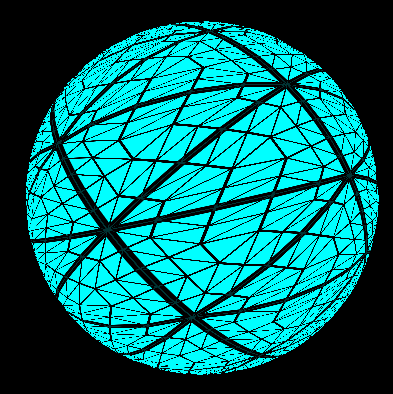Trials and Tessellations
Tessellation works! I was able to replicate the fantastic tutorial from The Little Grasshopper and finally get a test of a pipeline with all 5 programmable stages.
This took a little longer than expected as my GPU complained on the following shader
Error compiling tess-control-shader: 0(6) : error C5227: Storage block FROM_VERTEX_STAGE requires an instance for this profile 0(13) : error C5227: Storage block FROM_TESSELLATION_CONTROL_STAGE requires an instance for this profile
#version 450
in _FROM_VERTEX_STAGE_
{
in vec3[3] _VERTEX_STAGE_OUT_1;
};
layout (vertices = 3) out;
out _FROM_TESSELLATION_CONTROL_STAGE_
{
out vec3[] _TESSELLATION_CONTROL_STAGE_OUT_0;
};
void main() {
vec3 g_G1327 = _VERTEX_STAGE_OUT_1[gl_InvocationID];
vec3 g_GEXPR01328 = g_G1327;
_TESSELLATION_CONTROL_STAGE_OUT_0[gl_InvocationID] = g_GEXPR01328;
float TESS_LEVEL_INNER = 5.0f;
float TESS_LEVEL_OUTER = 5.0f;
if ((gl_InvocationID == 0))
{
gl_TessLevelInner[0] = TESS_LEVEL_INNER;
gl_TessLevelOuter[0] = TESS_LEVEL_OUTER;
gl_TessLevelOuter[1] = TESS_LEVEL_OUTER;
gl_TessLevelOuter[2] = TESS_LEVEL_OUTER;
}
}
As far as I can tell, the above code is valid according to the spec, but my driver wasn’t having any of it[0]. This meant I had to do some moderate code re-jiggling. You can’t just add an instance name to the blocks as then you get:
Error Linking Program 0(13) : error C7544: OpenGL requires tessellation control outputs to be arrays
Grrr. This makes total sense according to the spec though, so grr goes back to error C5227. FUCK YOU C5227.
Anyway that got fixed and this happened

With that done I made sure the same worked using CEPL’s inline glsl stages and tested a bunch.
This left me at an odd point. CEPL has a lot less gaps in the API that it used to[1], it feels kind of ready for me to use.
So I sat down with The Book of Shaders and got started. I simply can’t give that project enough praise, it’s wonderfully written and remains interesting whilst also pushing you just enough to really digest the details of what they want you to learn. I made a little shadertoy substitute[2] and started doing the exercises. I have to say I’m pretty proud with how fun it all felt, it’s been a lot of work to get something that is lispy but doesn’t feel hampered by being the non-native language, so those hours of play were very vindicating.
Within a very short time The Book of Shaders is getting you to amass a collection of helper functions for your shaders. I already have a (very wip) project called Nineveh for this purpose, so it’s time to start working on that again! I want a kind of ‘standard library’ for CEPL, somewhere you can find a pile of implementations of common functions (e.g. noise, color conversion, etc) to either use to at least use as a starting point.
There are often cases where libraries like this fall short as you want a slight variation on a shader. Say for example you like their FBM function but want one more octave of noise. I’m hoping macros can help a little here as we can provide something that generates the variant you need.
This is likely naive but it’ll be fun to try.
Right, that’s my lot for now. Seeya!
[0] I was meant to be using the compatibility profile too so I’m not sure what was up
[1] See last weeks post for what remains
[2] There’s about 50 lines not shown here which handles input & screen events.
(in-package :ctoy)
(defun-g ctoy-quad-vert ((pos :vec2))
(values (v! pos 0 1)
(* (+ pos (v2! 1f0)) 0.5)))
(defun-g ctoy-quad-frag ((uv :vec2)
&uniform (now :float)
(mouse :vec2) (mouse-norm :vec2) (mouse-buttons :vec2)
(screen-res :vec2))
(v! (/ (s~ gl-frag-coord :xy) screen-res) 0 1))
(def-g-> draw-ctoy ()
:vertex (ctoy-quad-vert :vec2)
:fragment (ctoy-quad-frag :vec2))
(defun step-ctoy ()
(as-frame
(map-g #'draw-ctoy (get-quad-stream-v2)
:now (* (now) 0.001)
:mouse (get-mouse)
:mouse-norm (get-mouse-norm)
:mouse-buttons (get-mouse-buttons)
:screen-res (viewport-resolution (current-viewport)))))
(def-simple-main-loop ctoy
(step-ctoy))